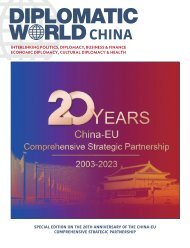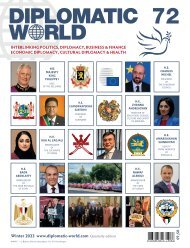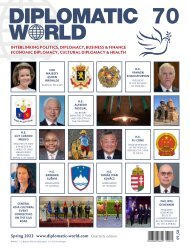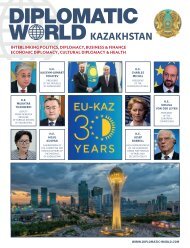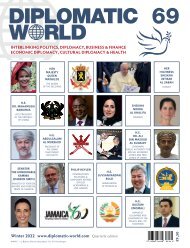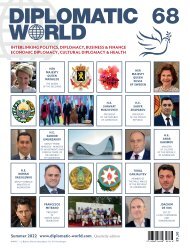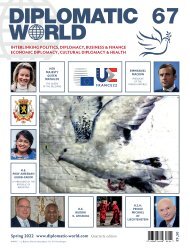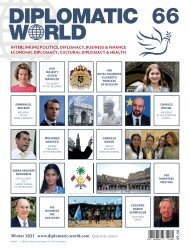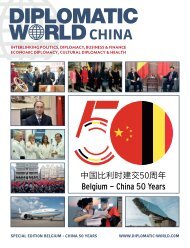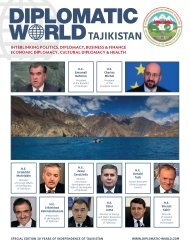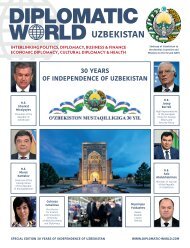Diplomatic World 67
You also want an ePaper? Increase the reach of your titles
YUMPU automatically turns print PDFs into web optimized ePapers that Google loves.
A TAXONOMY<br />
OF AUTHORSHIP AND THE HAND<br />
OF SIR ANTHONY VAN DYCK<br />
IN HIS FIRST ANTWERP PERIOD 1615-20<br />
IN MEMORIAM DR. ARNOUT BALIS<br />
Univ. Prof. Dr. hc Jan De Maere<br />
University of Art & Design, Cluj-Napoca<br />
Anthonis Van Dyck and Studio,<br />
Cook version, 112 x 11,5 cm, c. 1620<br />
X-ray Cook version<br />
In red, reworked parts in a second stage<br />
of the Cook version<br />
ABSTRACT<br />
teraction, involved in the two best (known) versions of the Family<br />
portrait of Cornelis de Vos and his Family, interdisciplinary exam-<br />
For the first part of van Dyck’s career, when in Rubens’ studio,<br />
inations high-end technological methods, such as X-radiography,<br />
little can be said about the specific characteristics of the best<br />
X-ray computer tomography, mammographic tomosynthesis and<br />
assistant’s paintings compared to these of Van Dyck’s own hand.<br />
macroscopic X-ray fluorescence, can be employed to render the<br />
Some of Sir Anthony Van Dyck’s early paintings exist in different<br />
overpainted layers visible again.<br />
versions. Different versions, copies and replicas of his paintings<br />
are often contemporary, sometimes from his workshop while<br />
Recently, connoisseurship experienced a revival due to the latest<br />
others are later copies by others.<br />
technological developments of the material analysis and history<br />
As Rubens did, Van Dyck had apprentices and assistants (gezellen)<br />
to work on his paintings. The issue of originality, invention<br />
of old master paintings. Nevertheless, technology did not offer<br />
a definite meta-methodological tool 2 replacing the traditional<br />
connoisseurship. It reveals the need of a special kind of interdis-<br />
Anthonis Van Dyck and Studio,<br />
Baron Janssen version, 115 x 111,5 cm, c. 1620<br />
Xray Baron Janssen version<br />
and authorship while acknowledging the status of a painting had<br />
ciplinary connoisseurship 3 .<br />
become a concern since the last quarter of the XVIth century<br />
in Antwerp. Flemish vernacular language developed a nuanced<br />
Technology allows in some cases to refine the distinction be-<br />
vocabulary for artistic replication with a precise taxonomy. The<br />
tween the production of the master and that of his workshop,<br />
analysis of different versions in the light of the ‘hand of the mas-<br />
and between different versions. The actual state of mastery and<br />
ter’ needs categorization in an adequate taxonomy.<br />
authorship in Anthony van Dyck’s paintings is not tethered to the<br />
physical execution of paintings in the same way as in Modernity,<br />
In the art market, the word ‘workshop’ indicates a lesser qualita-<br />
where the polarization of the terms ‘hand of the artist’ and ‘copy’<br />
tive criterium, but in art history it relates to the precise ontological<br />
are the primary locus for authorship.<br />
context of the creation of the painting. An Antwerp studio of a<br />
famous master was an organized industry directed by a skilful<br />
Authenticity in Antwerp in early XVIIth century terms is more<br />
and educated entrepreneur, the master.<br />
anchored in invention than in execution. As in the earlier painting<br />
practices of the XVth and XVIth centuries, collaboration in<br />
He was assisted, even for his autograph paintings by several<br />
famous artist’s workshops, both vertically and horizontally, often<br />
assistants who had to follow his style. Some of them had some-<br />
involved assistant work on the same panel or canvas 4 .<br />
what creative freedom expressed in their individual ‘ductus’, as<br />
the young Van Dyck in Rubens’s studio 1 . His artistic dialog with<br />
‘Multiple hands’ is the rule for the most successful artists of the<br />
Rubens determined the first Antwerp period of his career.<br />
early 17th century in Antwerp, heavily relying on gifted assistants<br />
5 , but the degree of implication of the master determined<br />
1* THE YOUNG ANTHONY VAN DYCK<br />
greatly pricing.<br />
To reconstruct the genesis and the degree of master-studio in-<br />
The young Van Dyck wants to emulate Rubens and to develop<br />
Comparison X-rays, left Baron Janssen version-right Cook version<br />
108 109





